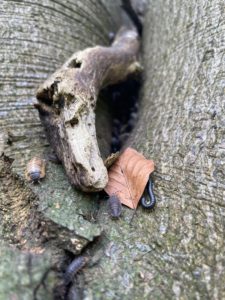The Crack of the Beech

Photo of a stick in the fold of a tree trunk. There is a dead leaf, some woodlice, and a millipede in the foreground. At the back, in the fold or crack of the trunk, are lots of other blurry insects.
This hub of activity is called the Crack of the Beech. It’s an on-tree marketplace of ideas where the insects of Charing go to plan for all the futures they can imagine. If you try to imagine one of those futures, that will make one more they have to plan for, so try to make it an interesting, insect-friendly one, okay?
Anyway, the Crack of the Beech. To be honest, I was quite surprised by how busy it was, which shows the kinds of prejudices I have about insect life. I moved that stick because why not? I was just a stick! (My apologies to Stick Nation.) Well, why not is because it was actually a ceiling under which a highly important insect meeting was occurring.
That big fat beige louse is a security guard called Tom; if you look closely, you can see he’s shaking a tiny little fist at me. My bad, Tom, calm down, I admit my error and prejudices. In the end, you’ll be pleased to know that Tom and I worked it out; he let me stick around (heh!) for a while after I promised to report on their above crack activities, and not engage in espionage or any such thing.
The millipede scurrying under the leaf is called Dorothea, and she was one of the most important insects of that particular gathering. She was late, because she’s always running late, but no one minds as she travels from the furthest reaches of the woods and carries messages from afar.
Dorothea is what is called a Connecting Insect, because she burrows tunnels which enable insects from other areas to pass on their plans and ideas for the future. They whisper the plans down the tunnels and Dorothea kind of catches them in a way I don’t fully understand (reportage, not espionage, remember?), and then brings them all to the next meeting. That’s why she’s always late, as so many of her legs are busy carrying rather than walking.
This particular meeting is about planning for Future 334976A and involves extensive participation from ladybirds and starlings. It’s not often that starlings feature positively in an Insect Plan, but that just goes to show the multi-species collaboration that is beginning to occur before our arrogant and unseeing eyes. In Future 334976A, the starlings of Kent have engaged in a temporary ceasefire with insects (not one peck, they promised!), in order to weave a web of human destruction. The starlings will entrance us with some extraordinary flight patterns, and once we are properly distracted, all the ladybirds will bite us and all of us will be allergic. Don’t blame me for being bad minded, I’m just passing on what Tom told me.
Despite hearing that terrifying story, I still strongly suspected that not all Insect Futures were detrimental to humans. After putting that proposition to Tom, he agreed. For instance, he said that Future 432F was for when humans weren’t selfish resource hoggers and had rewilded the entire world. In that Future, the spiders plan to call a truce with arachnaphobes and agree to stay out of our homes for ever and ever, amen. I can’t tell you how happy I am about that one, so I’d be grateful if you could start rewilding the world about you pronto.
